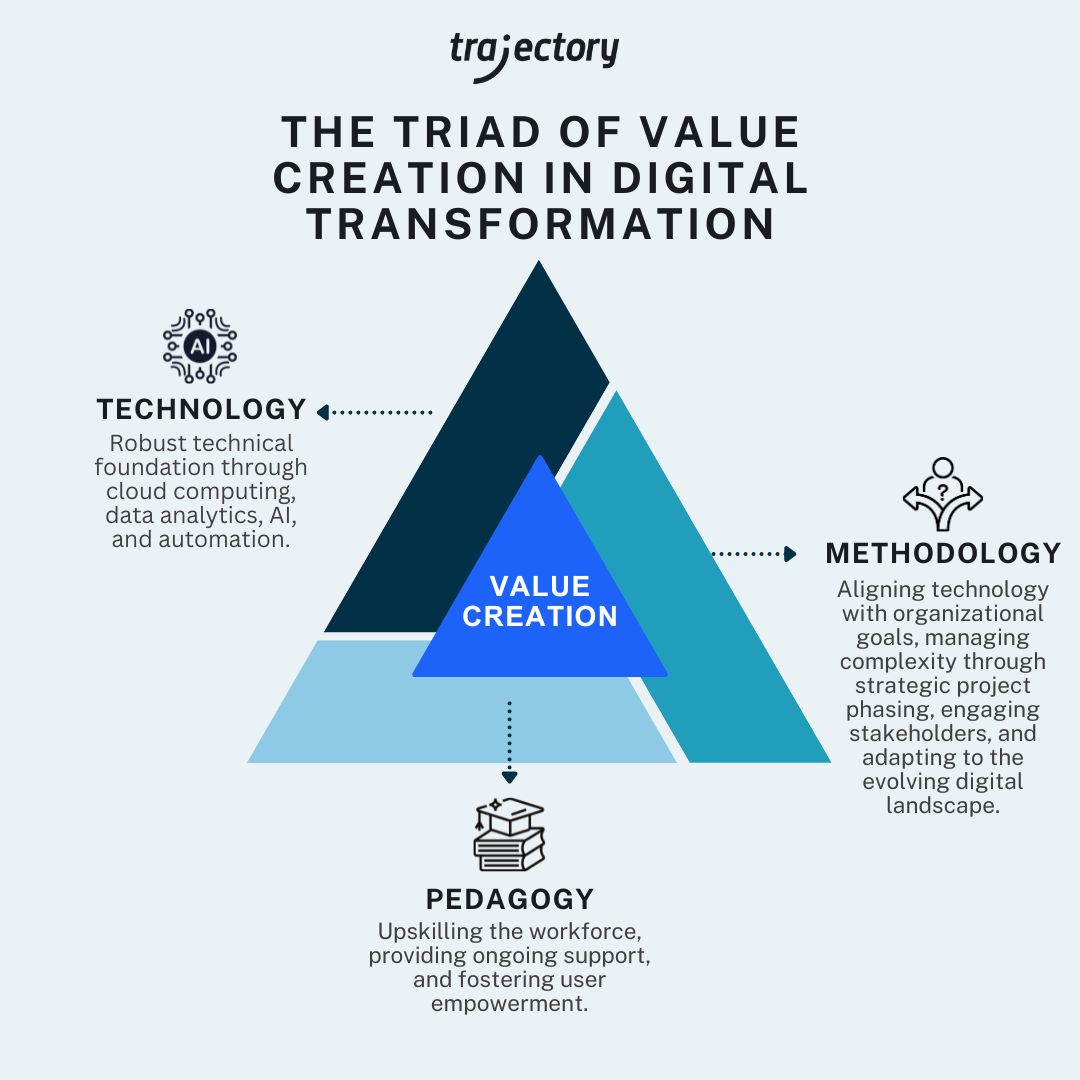Introduction
In today’s rapidly evolving technological landscape, businesses are under intense pressure to harness emerging technologies or risk falling behind. A recent KPMG survey reveals that 72% of CEOs are prioritizing investments in these technologies to stay competitive.¹ Data shows that organizations focused on digital innovation excel in areas such as customer satisfaction, response times, customer lifetime value, acquisition rates, and marketing ROI.² However, even established companies often struggle to compete with digitally adept rivals.
Successfully implementing digital transformation, especially for large organizations, requires a strategic approach. A CIO report highlights that 49% of executives find it significantly challenging to keep pace with technological advancements.³ This underscores the need for a well-planned digital strategy, as organizations that effectively leverage technology gain a substantial competitive advantage.
Digital Transformation Challenges for Large Organizations
Large enterprises face unique digital transformation challenges, including:⁴
- Cultural Shift: Long-standing organizational cultures may need to evolve to embrace new digital methodologies.
- Legacy Systems: Integrating new digital solutions with existing, complex infrastructures can be technically challenging.
These complexities render generic, one-size-fits-all strategies ineffective, emphasizing the need for custom digital transformation approaches tailored to each enterprise’s specific challenges, existing technology ecosystems, and overall business goals.

The Four Pillars of Digital Transformation Success
To realize the full potential of digital transformation, organizations must build their approach on four key pillars:
- Business-First Mindset: Align technology with strategic goals.
- Strategic Project Phasing: Manage risk through phased implementation.
- Collaborative Implementation Teams: Leverage diverse expertise for informed decision-making.
- Continuous Onboarding and Support: Sustain transformation with ongoing training and support.
Pillar 1: Business-First Mindset
Understanding core business needs before selecting technology ensures alignment with strategic goals. This process begins with scoping and blueprinting, a critical deep-dive phase that involves:
- Comprehensive Documentation: Mapping workflows, departmental interactions, and existing processes to identify productivity bottlenecks and silos.
- Strategic Prioritization: Targeting root causes of inefficiencies rather than surface-level issues to create transformation initiatives that lead to lasting improvements.
- Process Consolidation: Streamlining workflows by eliminating redundancies and aligning actions more closely with strategic goals.
This approach offers tangible benefits, such as data-driven personalization and strategic alignment, enabling organizations to anticipate customer needs, reduce costly mistakes, and create personalized solutions that strengthen their competitive position.
Pillar 2: Strategic Project Phasing
Strategic project phasing involves breaking the digital transformation journey into manageable phases, allowing organizations to learn and adapt incrementally. This method helps manage risk and creates a series of “mini transformations,” each building on the previous one. Key phases include:
- Phase 1: Implement core business processes.
- Phase 2: Roll out to all departments.
- Phase 3: Optimize automation and add functionalities post-stabilization.
Success hinges on factors like manageable scope, gradual adoption, built-in scalability, and continuous improvement. Organizations that master this approach develop the capability to manage complex change effectively, fostering ongoing innovation and agility.
Pillar 3: Collaborative Client/Partner Implementation Teams
The success of digital transformation relies heavily on the composition and dynamics of implementation teams. Collaborative client/partner teams represent a shift from traditional vendor-client relationships to a more integrated, synergistic approach. This model blends external expertise with internal knowledge, ensuring that technological solutions are both technically sound and aligned with business goals.
Key areas of focus include:
- Data Migration: Ensuring data integrity, relevance, and accuracy.
- Cultural Impact: Fostering ownership and reducing resistance to change.
- Feedback Loop: Allowing rapid iteration and adjustment to ensure effective solutions.
This collaborative model enhances the organization’s ability to innovate and adapt, creating a template for future cross-functional collaboration.
Pillar 4: Continuous Onboarding and Support
Implementing new technologies and processes is just the beginning; sustaining and evolving these changes is the real challenge. Continuous onboarding and support are essential for long-term success, involving:
- Scalable Training Solutions: Tailored to individual roles.
- Adaptability: Evolving training programs with business needs.
- Ongoing Support: Regular skill refreshers and on-demand help.
- Data-Driven Insights: Adjusting training and support strategies in real time.
- Empowerment: Enabling employees to actively participate in the digital transformation.
This approach ensures that the entire organization is equipped to navigate a rapidly evolving landscape.

The Future of Digital Transformation
Success in digital transformation goes beyond just technology; it’s about strategy, culture, and execution. The four pillars—a business-first mindset, strategic project phasing, collaborative implementation teams, and continuous onboarding and support—represent a new way of approaching change in the digital age.
Looking ahead, several trends will shape digital transformation:
- Hyper-Personalization: Crafting tailored transformation roadmaps based on unique organizational needs.
- Ecosystem-Driven Transformation: Extending efforts beyond single organizations to include entire business ecosystems.
- Ethical and Sustainable Transformation: Prioritizing ethical and sustainable practices as societal impacts grow.
- Cognitive Transformation: Augmenting human decision-making with AI and advanced analytics.⁶
- Resilience Through Flexibility: Rapidly adapting digital capabilities in response to market changes.
Successful Large-Scale Digital Transformation with the Right Partner
The most successful organizations are those that can institutionalize the capacity for change, creating cultures and systems that are inherently adaptable. In this context, partners like Trajectory are essential. The complexity and fast pace of change demand more than just technical expertise—they require a partner that can provide strategic insight and offer flexible, personalized solutions that evolve with the organization’s needs.
Trajectory, with its deep business understanding and technical expertise, is well-positioned to guide large enterprises through this complex landscape. By offering tailored strategies that respect each organization’s unique context while leveraging best practices and cutting-edge technologies—including Cognita, our proprietary e-learning platform – Trajectory helps turn digital initiatives from isolated projects into drivers of holistic organizational transformation.⁷
As we look to the future, the organizations that will thrive are those that embrace change as a constant, leveraging digital technologies not just to improve current processes but to imagine entirely new ways of creating value. In this journey, having the right partner—one that combines strategic vision with practical execution—can make all the difference.
References:
- KPMG Study: CEOs Focused on Game-Changing Investments in M&A and Generative AI to Drive Growth (kpmg.com)
- The 4 Pillars of Successful Digital Transformations (https://hbr.org)
- What is digital transformation? A necessary disruption (cio.com)
- Navigating The Journey Of Digital Transformation In Large Enterprises (forbes.com)
- Pathways to Digital Service Innovation: The Role of Digital Transformation Strategies in Established Organizations (Springer)
- The Next Frontier in Business Transformation: AI-Driven Operational Improvement for Mature Technology Ecosystems (Trajectory)
- Cognita E-Learning Training Platform

Alex Olano
CEO, Managing Partner
Throughout his 18-year career at Trajectory, Alex’s role has ranged from managing teams and projects to running the professional services organization, and mentoring Trajectory’s growing number of Consultants. Currently, he leads the Trajectory Team and invests his time ensuring Private Equity avoids key technology risks during their transactions. Alex understands technology is simply the means for achieving business goals. He has guided Trajectory’s organization to form its own version of Operational Improvement, which combines industry and business acumen with highly effective technology implementation capabilities. Prior to joining Trajectory Group, Alex spent 10 years in business consulting, systems advisory, and SAP implementations with IBM Global Services and Accenture.



